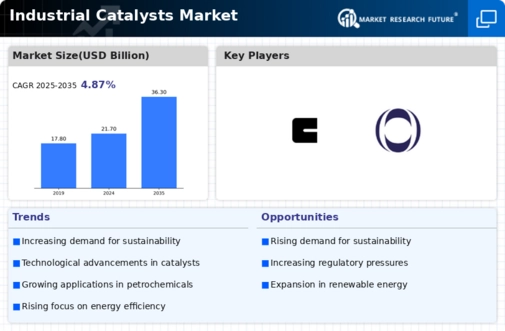Market Share
Industrial Catalysts Market Share Analysis
Market Share Positioning Strategies of Industrial Catalysts Market:
Research and Development (R&D) Investment:
Allocating resources to R&D activities enables the development of innovative catalyst formulations with superior performance and efficiency.
Continuously improving catalyst technologies to meet evolving industry demands for enhanced selectivity, durability, and environmental sustainability strengthens market positioning.
Application-Specific Product Development:
Tailoring catalyst formulations to specific industrial processes and applications, such as petroleum refining, chemical synthesis, or environmental remediation, addresses unique customer requirements.
Offering a diverse range of catalysts optimized for various reactions and industries broadens market appeal and fosters customer loyalty.
Quality Assurance and Regulatory Compliance:
Implementing stringent quality control measures ensures consistency and reliability in catalyst performance, meeting industry standards and regulatory requirements.
Obtaining certifications and approvals, such as ISO 9001 or REACH compliance, enhances credibility and facilitates market acceptance, particularly in highly regulated sectors.
Strategic Partnerships and Alliances:
Collaborating with industry partners, including chemical manufacturers, refineries, and engineering firms, enhances market reach and access to new customers.
Forming strategic alliances for joint research projects, technology licensing, or distribution agreements strengthens competitive positioning and accelerates market penetration.
Market Segmentation and Targeting:
Segmenting the market based on factors such as industry verticals, geographic regions, or specific catalyst applications enables targeted marketing efforts.
Customizing marketing strategies and product offerings for segments like petrochemicals, pharmaceuticals, or automotive catalysis optimizes resource allocation and enhances market penetration.
Price Positioning Strategies:
Employing competitive pricing strategies relative to catalyst performance, value proposition, and market dynamics helps capture market share while maintaining profitability.
Offering flexible pricing structures, volume discounts, or value-added services enhances customer affordability and incentivizes long-term partnerships.
Geographical Expansion and Market Diversification:
Capitalizing on growth opportunities in emerging markets and expanding geographic presence diversifies revenue streams and mitigates risks associated with regional market fluctuations.
Establishing local production facilities or distribution networks in key regions improves market responsiveness and strengthens competitive positioning.
Technological Differentiation and Intellectual Property Protection:
Investing in proprietary catalyst technologies and securing patents safeguards intellectual property rights and creates barriers to entry for competitors.
Leveraging technological advancements, such as advanced catalyst synthesis methods or novel catalytic materials, enhances product differentiation and market competitiveness.
Environmental Sustainability Initiatives:
Developing eco-friendly catalyst formulations or processes with reduced environmental footprint aligns with growing industry and consumer demand for sustainable solutions.
Promoting green catalysts with lower energy consumption, reduced emissions, or recyclability enhances brand reputation and attracts environmentally conscious customers.
Customer Relationship Management (CRM) and After-Sales Support:
Providing personalized customer support, technical assistance, and ongoing maintenance services fosters strong relationships and customer loyalty.
Soliciting feedback and incorporating customer input into product development initiatives demonstrates responsiveness to market needs and strengthens market positioning.






Leave a Comment